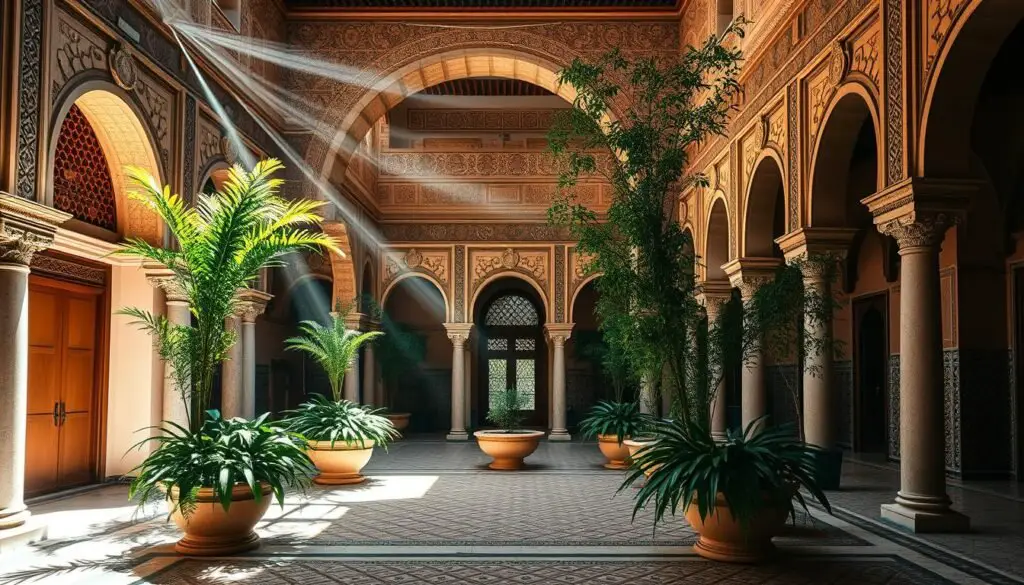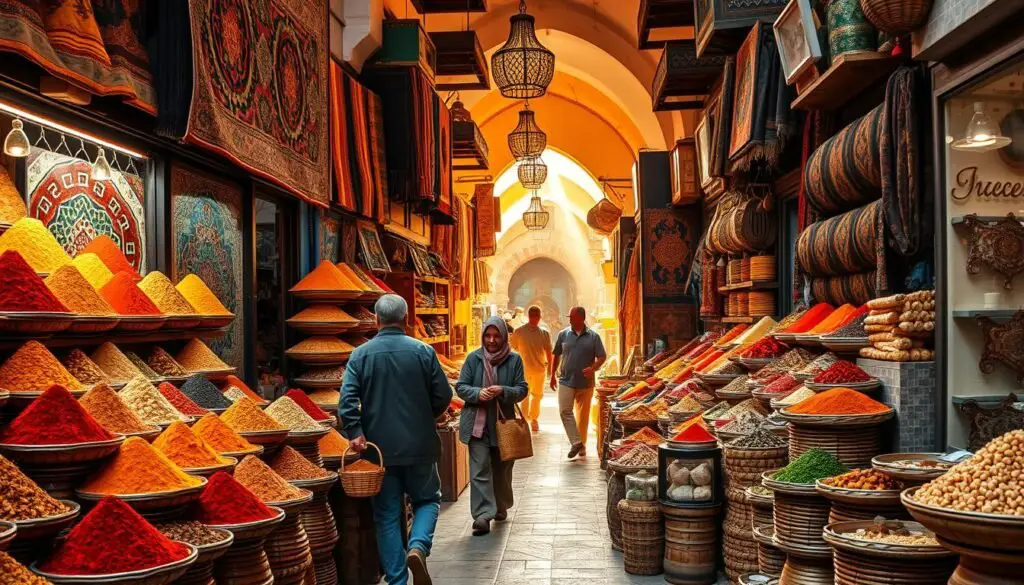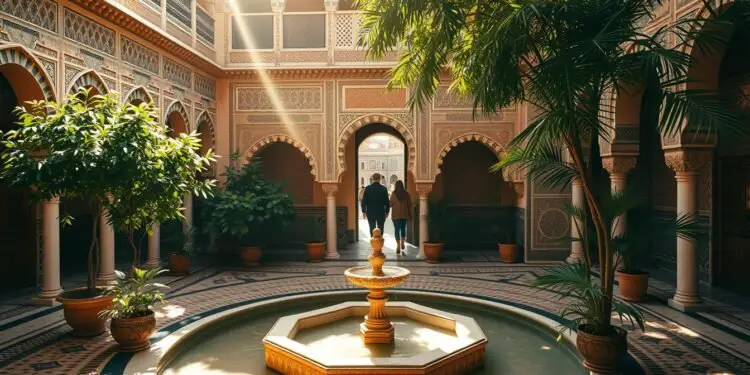Have you ever wondered what it’s like to step into a living piece of history? The 14th-century architectural marvel in the heart of Morocco offers a glimpse into a world where education, commerce, and artistry intertwined seamlessly.
Built between 1323 and 1325 by Marinid Sultan Abu Sa’id, this UNESCO-listed gem stands as a testament to Moroccan craftsmanship. Its intricate designs and strategic location near the bustling spice market make it a cultural hotspot.
Adjacent to the world’s oldest mosque university, this site blends spiritual learning with vibrant trade. The courtyard dazzles visitors with its detailed mosaics and serene atmosphere, transporting them back to the golden age of the Marinid dynasty.
Key Takeaways
- A stunning example of 14th-century Marinid architecture.
- Located steps away from the historic Souk al-Attarine.
- Recognized as a UNESCO World Heritage Site.
- Features breathtaking mosaics and tranquil spaces.
- Combines rich history with modern-day exploration.
The Rich History of Attarine Fes
The Marinid dynasty reshaped Morocco’s intellectual landscape through strategic educational investments. Their 14th-century madrasas, like Attarine, were more than schools—they were tools to unify Sunni orthodoxy and train loyal officials.
Marinid Dynasty and the Rise of Madrasas
The Marinids built over 14 madrasas to counter Almohad ideology, which rejected formal religious architecture. These institutions promoted Sunni teachings and produced skilled bureaucrats. Unlike the Almohads, the Marinids saw education as key to political stability.
Construction and Endowment by Sultan Abu Sa’id
In 1323, Sultan Abu Sa’id laid the foundation for Attarine, attended by scholars. The madrasa housed 50-60 students from cities like Tangier, supported by a habous trust. Stipends covered their needs, ensuring focus on studies.
By 1915, the site gained heritage status. Today, preservation efforts protect its original design, from zellij tiles to carved stucco. This century-old legacy remains a testament to Marinid vision.
Architectural Marvels of Attarine Fes
Limited space sparked creativity in this 14th-century marvel’s design. Marinid architects transformed tight urban plots into functional artistry, blending geometry with sacred purpose.

Intricate Courtyard Design and Zellij Tilework
The courtyard dazzles with a tripartite decor scheme. A base of tiles in geometric patterns supports stucco-carved calligraphy bands, crowned by cedarwood eaves.
Over 600 square meters of zellij mosaic cover surfaces, each piece hand-cut. The marble fountain anchors the space, reflecting sunlight through yellow-white columns.
Prayer Hall and Unique Spatial Solutions
An asymmetric qibla alignment demanded innovation. Architects adjusted the mihrab 45° using a triple-arched gallery and wooden cupola.
The L-shaped entrance optimizes the cramped footprint. Upstairs, 30 student rooms line narrow corridors, now under restoration.
Decorative Elements: Stucco, Wood, and Bronze
Saadian-era cedar frames doors and ceilings, carved with floral motifs. Bronze-plated replicas replace original doors, while Moroccan marble floors endure.
UNESCO preserved the 14th-century chandelier, inscribed with the founder’s name. Sgraffito calligraphy bands weave Quranic verses into stucco walls.
Cultural and Educational Significance
Beyond its stunning tiles, this madrasa fueled Morocco’s golden age of learning. Operated alongside Al-Qarawiyyin—the world’s oldest university—it prepared students for advanced studies in Islamic law and Arabic grammar.
The curriculum focused on Maliki jurisprudence, shaping scholars who later taught at Al-Qarawiyyin. Teachers here gained prestige, their appointments elevating the school’s reputation across North Africa.
Students didn’t just study—they lived in the city, supporting local souks. Their daily needs fueled the spice market’s economy, blending education with commerce.
Unlike older institutions like Saffarin Madrasa (1271 CE), Attarine’s design prioritized function. Its compact layout mirrored the center’s focus on intensive learning.
Today, the madrasa welcomes non-Muslim visitors, offering rare access to Morocco’s educational heritage. Nearby mosques remain restricted, making this a unique window into Fes’s intellectual legacy.
Exploring the Souk al-Attarine Connection
The scent of saffron and amber fills the air just steps from this historic landmark. Souk al-Attarine, a 13th-century spice and perfume market, lies 200 meters from the madrasa’s entrance. Its name hints at its legacy—”Attarine” derives from Arabic for “perfumers.”

Stalls overflow with argan oil, dried roses, and cumin, their patterns of colors mirroring the madrasa’s zellij tiles. This place once funded scholars through habous endowments, linking commerce to education.
For the best experience, explore the madrasa in the morning. Then dive into the market’s afternoon bustle. Capture the contrast—tranquil courtyards versus the souk’s energetic chaos.
The souk remains the city’s cultural center, where trade and tradition collide. Every spice sack tells a story of Morocco’s enduring craftsmanship.
Visitor Tips for Attarine Fes
Planning your visit to this historic site? Here’s what you need to know. This place blends stunning architecture with practical logistics for travelers.
Timing and Tickets
Open daily from 8 AM to 6 PM, the madrasa charges 20 MAD (about $2) per person. Groups of 10+ get discounted rates at 15 MAD each.
Arrive before 10 AM to avoid crowds. Fridays may close briefly for prayers, so check schedules.
What to Expect
Some areas, like the upper-floor rooms, are occasionally off-limits. Guides are available to explain calligraphic inscriptions and the design details.
Photography is allowed, but respect the quiet atmosphere. The courtyard’s tiles and mosaics are highlights—don’t rush past them.
Nearby Gems
Pair your visit with the Nejjarine Museum, just a 3-minute walk away. The Souk al-Attarine spice market is another must-see.
For deeper insights, book a guided tour covering the madrasa and Al-Qarawiyyin University.
Conclusion
This madrasa stands as a living museum of Moroccan artistry. Its courtyard dazzles with 14th-century zellij patterns, preserved with 95% original elements intact.
Think of it as Hassan II Mosque’s historic counterpart—smaller but equally rich in detail. Golden-hour photos of the geometric tiles make perfect Instagram highlights.
Remember to admire without touching. The delicate stucco and woodwork need protection for future generations.
Pair your visit with Chouara Tannery or Al-Qarawiyyin University to dive deeper into Morocco’s cultural legacy.
FAQ
When was the Attarine Madrasa built?
The school was constructed in the 14th century under Sultan Abu Sa’id of the Marinid Dynasty.
What makes the architecture special?
It features stunning zellij tilework, carved stucco, and a peaceful courtyard with intricate patterns.
Is the madrasa still used for education?
No, it no longer functions as a school but remains a historic and cultural landmark.
How is the souk connected to the madrasa?
The nearby spice market shares the same historic district, blending commerce and learning.
What’s the best time to visit?
Early mornings or late afternoons avoid crowds, and light enhances the tile designs beautifully.
Are there entrance fees?
Yes, a small fee is required, often included in guided tours of Fes’s historic sites.




